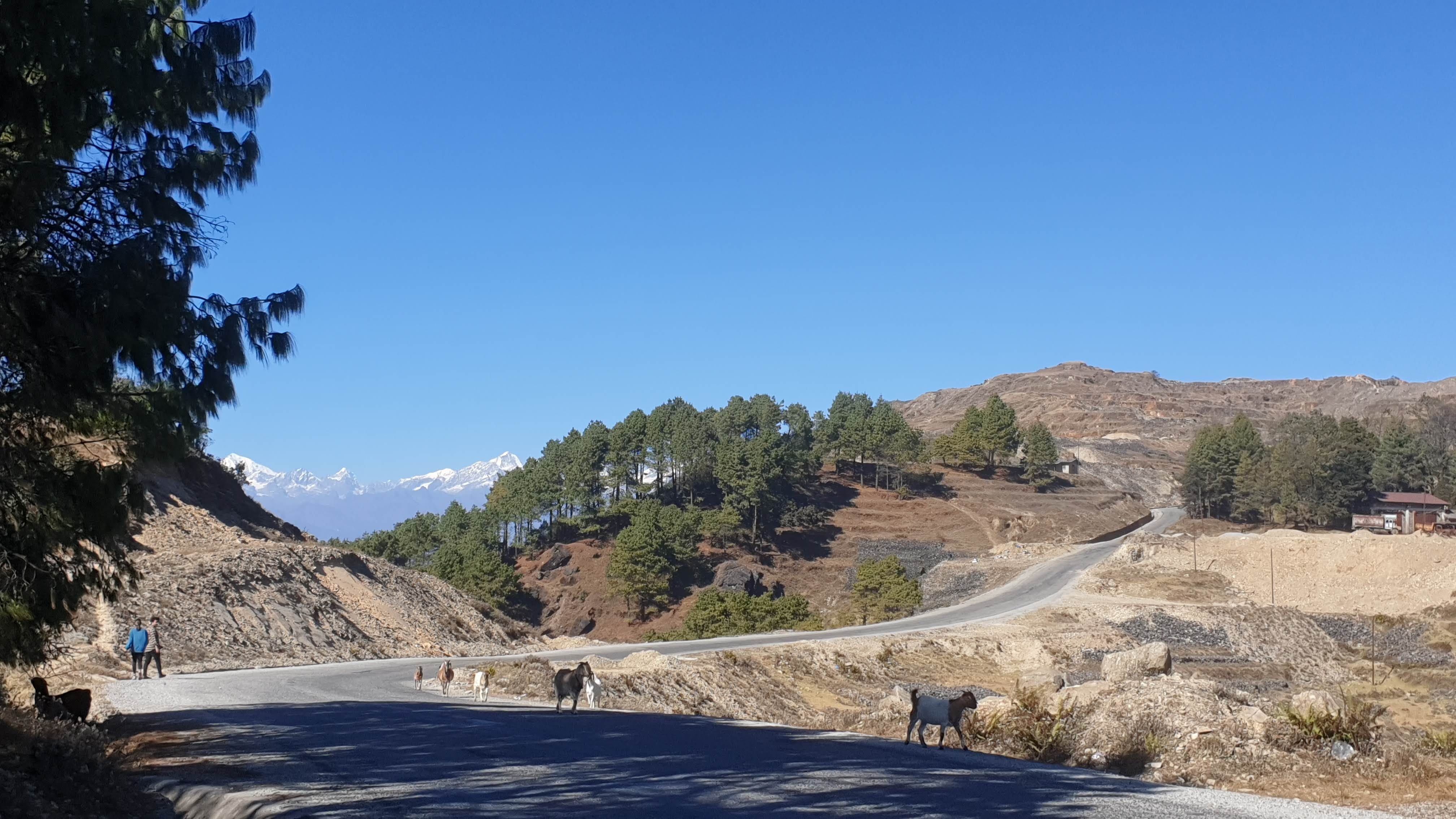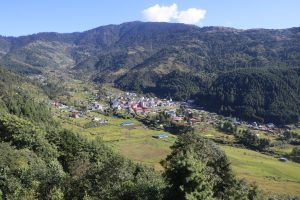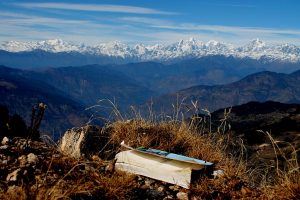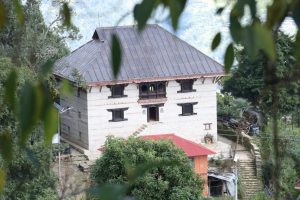
I stood mesmerised. For a moment, I had an eerie feeling that the figure before my eyes was not the Rameswor whom I knew, but a complete stranger . . . like someone possessed. “Am I seeing a god?” I asked myself. Suddenly, a chill went down my spine and the hairs on my arms stood on the end like the quills on a porcupine.
Treading closely on the heels of youngsters of Dolakha (1,675m), a small town 135 km northeast of Kathmandu, Rameswor Shrestha, too, was drawn by the glitz and glamour of Kathmandu. No sooner had he finished his School Leaving Certificate (SLC) exams than he left Dolakha at an age of 17 to explore the sprawling, bustling megalopolis he always dreamt about.
The trend of mass exodus to Kathmandu among the young Dolakhes (people of Dolakha) dates back to more than a century and it still continues to this day. Small wonder, like all his young fellow villagers, Rameswor, too, eventually settled down in Kathmandu.

But all these years (today, he is fifty and a father of three grown-ups–two sons and a daughter), he never missed out on a trip back home to Dolakha to celebrate Vijaya Dashmi or Dashain (mahani in the local dialect). Most of the native Dolkhes away from their hometown spare no effort to make it to Dolakha every Dashain. It’s during Dashain when the almost deserted town the rest of the year teems with the homecoming crowd.
Rameswor happens to be a first cousin to me. To my question, how long have you been visiting your hometown every Dashain, he scratched his head, and said, “Must’ve been more than 20 years now, dai (brother)?” That was 10 years ago when he was 40 years old.
Homeward bound
The year 2009 for Rameswor was no different. With only a few days left before the Dashain holidays, Rameswor wrapped up the last minute work at his office, bought a bus ticket, shopped for some odds and ends to take back home including some medicines for his ailing mother and, not least, a new sari and necklace for his wife Parwati.
While the bus sped along the Araniko Highway, it never once crossed Rameswor’s mind that a surprise beyond his wildest imagination awaited him back home. The bus arrived in Dolakha (four-and-a-half km from Charikot) in about six hours. “Baba’s come! Baba’s come!” Rameswor’s son, Aleen, whooped with delight as he and Parwati rushed to greet him. Another son, Ayush, and daughter Alina grinned from ear to ear to see dad home.

For Rameswor, Dashain festivity first began with the usual puja (worship) at the Bhimeswor Temple followed by social calls to uncles, relatives, and sasurali (wife’s family); finding a stout goat for sacrifice; feasting; preparing for the tika ceremony and spending rest of the time with friends and kin, playing cards.
On the third day, Rameswor was invited for lunch at his 76-year-old uncle Cheeni Bahadur’s house. Once there and seated comfortably, Cheeni Bahadur broke the news, “Babu,” he said, “I don’t feel well and I’m afraid I won’t be able to perform this year’s Bhagwati’s role for the Khadga Jatra (Sword Festival). Since you’re the senior-most amongst your brothers, it looks you will have to take my place.”
In a quandary
That was the surprise, which awaited Rameswor in Dolakha. He was shell-shocked. “Kaka (uncle), I can’t even imagine myself replacing you,” he protested, shaken.
“Ke garne (What to do),” his uncle resumed, with a faint look of concern. “My health has failed me and the right candidate, your uncle Shyam, too, is in no shape to assume the responsibility.” Rameswor knew well that his younger uncle (an alcoholic for some years) would not stand a chance of taking on the solemn responsibility. But still . . . he kept debating with himself.
All kinds of questions wreaked havoc on Rameswor’s mind, to which he had no answers: How on earth am I supposed to take up this responsibility? How will I be able to pull it off? What if I lose my nerve and fail at the last moment? Odds are, I’ll botch it!
He snapped to attention at his uncle Cheeni’s words, “You can do it”, he said, as if reading Rameswor’s mind. “Don’t worry; I’ll be by your side to guide you, just in case.”
Rameswor’s fears were not unfounded. As a part of the ritual, he was to assume the formidable responsibility of performing as the Goddess Bhagwati (Durga) for the Khadga Jatra. Even the thought of it gave him the cold feet.
It further called for a gruelling march from morning until sundown, pirouetting down the street through the entire town brandishing a sword with one hand and a shield on the other on bare feet and an empty stomach. The hardship did not intimidate Rameswor; only a nagging doubt about his ability to perform it gnawed at him.
The night for Rameswor was a fitful one. But come morning the next day, Rameswor seemed determined. “No matter what, I’ll not bow out. I’ll accept what comes my way. It’s my good Karma and I can’t hold it back, “Rameswor said to himself. He was ready for the big challenge.
While Rameswor was going through all this, this scribe accompanied by his family happened to be in Dolakha for the Dashain holidays. As words got out about Rameswor taking on Cheeni uncle’s place for the Khadga Jatra, I became excited too and decided to cover the story.
Khadga Jatra
Each Dashain, the legendary Khadga Jatra is celebrated with pomp and festivity by Dolakha’s Newar residents (Dolkhes). Initiated as early as 1784 BS (1727 AD) during the reign of King Jagat Jai Malla, it has remained a cultural heritage of Dolakha to this day. The festival is observed during Dashain(next day of Tika ceremony) on the day of Ekadashi (the 11th day of lunar fortnight of Ashwin, in September/ October).

The festival marks the triumph of virtue over the forces of evil as the Gods set up a secret council to put an end to the terror begot by the danavs (demons). Pitched battles take place between the gods and the demons as a part of the festival.

The local performers clad in traditional attire replicate the mythological characters and reenact the battle scenes. The festival ends in the slaying of the demons, thus restoring peace and happiness among gods and mortals alike.
Falling in with this traditional custom, Kusules (clarinetists) and Kasains (butchers), although belonging to the lower caste, also form an alliance with the entire troupe taking on the role of the traditional ‘ensemble’ to play the ceremonial music.
As a prelude to the Khadga Jatra (a day before), two ethnic Thamis (also Thangmis) are summoned from a remote village called Dumkot, a day’s hike from Dolakha, to observe the Hipa Thami ritual. During the ceremony, the Thami men only clad in loincloth drink fresh blood of a buffalo calf sacrificed at the forecourt of the Devikot temple and parade through the street around town.
Khadga Jatra is celebrated during Dashain by the Newar communities in Kathmandu, Lalitpur, Bhaktapur, Kirtipur and Tokha.
—
The big day arrived. As the sun tipped the towering mountains in the northeast, over no less than the majestic Gauri Shankar(7,134m), I rushed to Rameswor’s house. The morning looked bright and the weather crisp befitting the grand occasion.

There was a big buzz about Rameswor’s house. Quite a number of relatives, well-wishers, and friends gathered to congratulate him and raise his morale. Amidst a flurry of activity, as the women fussed about the house, the men folk helped Rameswor into the traditional attire for the occasion. The costume consisted of a white daura (kind of shirt/ also a part of our national dress), a frock, a turban, and a patuka (cummerbund).
As flowers and jamara stalks (young barley shoots) were tucked wreath-like into his turban, a garland of jamara and dubo (green grass-blades) was placed around his neck. Uncle Cheeni lent a hand in the dress ritual, also giving Rameswor the last minute instructions. As the ceremony progressed, the women folk prepared sagun–an offering of local airak (alcohol), sautéed boiled egg, and dry fish, considered a good omen for the occasion. Soon, the contingent was all set to start.

Impersonating the Gods
Rameswor led the procession across the town with Uncle Cheeni by his side; the crowd followed suit and so did I. From Chamsali tole( neighborhood), the cavalcade headed for the kulyan (a sacred place where the ancestral deity is housed) past the historic Rajhiti (literally, the Royal stone spouts).

Along the way, more people joined the procession. At the kulyan, Rameswor’s contingent was reinforced by another group of elaborately dressed performing deities including Mul Khadga and the ceremonial band that consisted of the Kusules and the Kasains.
And to the beat of a dholak (drum), clarinets (similar to a shehnai; called muhari in the local dialect) and clashing cymbals the procession proceeded to the historic shrine, the Rajkuleswor, or also called the Taleju Bhawani (there are three temples of Taleju Bhawani in Kathmandu). The puja ceremony began as the performers lined up for the ceremonial handing of the weapons.
Cameras clicked and the flashes popped as shutterbugs jostled to get the best shot. I too jumped on the bandwagon. Rameswor duplicating as the Supreme Bhagawati was first to be handed down a shield (called dhal: made of animal hide) and a sword; other performers held only swords. The crowd grew huge at the forecourt of Rajkuleswor as a steady stream of people poured in.
Shortly, the head priest waved his hand to signal the start of the ceremony. Rameswor was to appear first and initiate the preliminary ritual dance wielding the sword and the shield invoking Goddess Durga or Bhagwati.

Time froze! I, for one, waited with bated breath. Fingers crossed! The drum sounded and went into a rhythmic lilt and the clarinets fell in with the beat. For a moment, I saw Rameswor hesitate. It seemed like ages before something propelled him into action.
And what I saw then made me stand rooted to the spot. Suddenly, Rameswor’s feet sprang into a rhythmic tap and his body started gyrating. As the tempo of the music grew, his arms swung from side to side with the sword and shield in a sweeping flow in perfect harmony with the beat.
Unbelievable! Only moments ago, I was watching a wavering man uncertain of himself, but next, he threw his shoulders back, his chin held high, while his face glowed and his eyes glinted.
I stood mesmerised. For a moment I had an eerie feeling that the figure before my eyes was not the Rameswor whom I knew, but a complete stranger . . . like someone possessed. “Am I seeing a god?” I asked myself. Suddenly, a chill went down my spine and the hairs on my arms stood on the end like the quills on a porcupine.
After three numbers, the music stopped with the clash of cymbals, and Rameswor appearing in a deep trance was led to the side. It was now time for other warrior gods to perform and one after another they reenacted the mock battle. The last to appear was the priest-commander, called the Yakargan.
Battling the demons
After this display, the performing gods with the Bhagwati (Rameswor) in the lead paraded across the street and the battle scene was rehearsed at several spots intervened by short breaks. As the warring gods proceeded through various streets doing short work of the demons, more warrior gods joined in as reinforcement.
People rushed and tripped over each other to get a closer look and touch the living gods by their feet and offer flowers.
Drenched in drama, the pageantry continued towards the famed Bhimeswor Temple. It was already past noon and the midday October sun seemed to sap the energy of the performers as volunteers offered water and fruit juice. Rameswor, too, looked a little weary; but when I asked him, he said that he was good.
The atmosphere seemed electric and the entire town of Dolakha bustled as people thronged around the streets to watch with consuming interest the ceremony in progress. Besides the distinct native Dolakha Newars, I noticed ethnic Tamangs, Thamis, Chhetris and Brahmins in the crowd.

Men, women, children, young and the old alike, all dressed in their best came from nearby villages and settlements. Some came from farther away. I talked to a 10-year-old Thami boy who walked for nine hours with his father to watch the festival.
Rameswor seemed confident by the time the dancing troupe reached the Bhimeswor temple and it was exhilarating to see my cousin flourish his weapons with abandon. At the forecourt of the temple lay three sacrificed buffalo carcasses symbolising the slain demons. Curiously, the locals claim that not a single fly sits on the slain carcass so long as the Khadga Jatra is in progress.

After Bhimeswor, the procession headed towards Devikot, a shrine that housed the Goddess Tripura Sundari, an incarnation of Bhagwati (the shrine building was razed to the ground by the 2015 earthquake). Shortly, the militia was reinforced by another warrior-God known for his ferocious fighting skill, Batuk Bhairav, who sported a garland of buffalo intestines.
TRIUMPH OVER EVIL
The day wore on. So did the stamina of the performers, weighed down as they were by their unwieldy attire and weapons. Even the sun appeared relentless as it bore down upon them, not to speak of the groaning stomachs and the singed and sore soles of their bare feet. They did not falter, however, but gallantly burst into renewed frenzy wreaking vengeance upon the demons. After all, they were supposed to be the Gods, no less!

As the shadows lengthened and the day drew near the end, Goddess Bhagwati and her aides parted company with the commander Yakargan, Batuk Bhairav and a score of other deities and retraced their steps back to Rajkuleswor for the closing ceremony.
Amidst chanting of tantric verses by the priests, a kubhindo (ash gourd) symbolising a marauding demon was placed in the forecourt to be hacked in two by the protagonist, the Bhagwati or Rameswor. Her aides would follow suit.

No sooner did Rameswor strike the gourd with his sword than a pandemonium broke out and before the other gods prepared to strike, an onslaught of spectators pounced in to get their hands on the severed gourd. It is believed that even a tiny piece of that miracle fruit if fed to the cattle stimulates fertility in them.
The Jatra came to an end as Bhagwati and her aides were ushered inside the shrine where they handed back their weapons. Relieved, Rameswor took a great sigh of relief– not that the ordeal was over, but because he had proved himself against his nagging fears. He felt gratified that he had lived up to the proud lineage so sacredly kept over the generations by his forebears.
The evening at Rameswor’s house buzzed with friends and relatives. We sat around sipping Parwati’s special airak (made from millet) as my cousin looking relaxed beamed at the compliments showered upon him. I could not wait to ask Rameswor the question, which squirmed like a worm in my mind all day.
I finally got the moment. “Rameswor, did you feel something as you took your first steps to launch yourself into the dance. You looked very jumpy at first, but all of a sudden you flung yourself into action, which really stumped me?”
Rameswor seemed uncertain, if not surprised, when he answered. “Dai, I can’t say for sure, but when I first stepped out from the doorway of Rajkuleswor, all nerves, all of a sudden it was as though a supernatural force possessed me and drove me to the waiting music.”
“My mind just failed to register, “he continued. “And I can’t call to mind of my having started the performance or end it. I came to my senses only when I was led to the side after the music stopped,” he added musingly.
The village elders in Dolakha still believe that some of those who perform in the Khadga Jatra are visited by the Gods–and only the chosen ones . . . possessed.
Now, it was my turn to cudgel my brains over it as I headed back home. “Was it just a fancy of my mind or did I really see a God in the person of Rameswor?” God alone knows!
























